NEWS &VIEWS
Forecasts, Commentary & Analysis on the Economy and Precious Metals
Celebrating our 48th year in the gold business
SPECIAL REPORT
October 2021
“If gold goes down – I hope I’m smart enough to buy more.
If it goes down a lot, I hope I’m smart enough to buy a lot more.”
Jim Rogers, Beeland Interests
––––––––––––––––––––––––––––––––––––––––––––––––––––––––––––––––––––––––––––––––––––––––––––––––––
Gold’s Century
While stocks dominated headlines, gold quietly performed
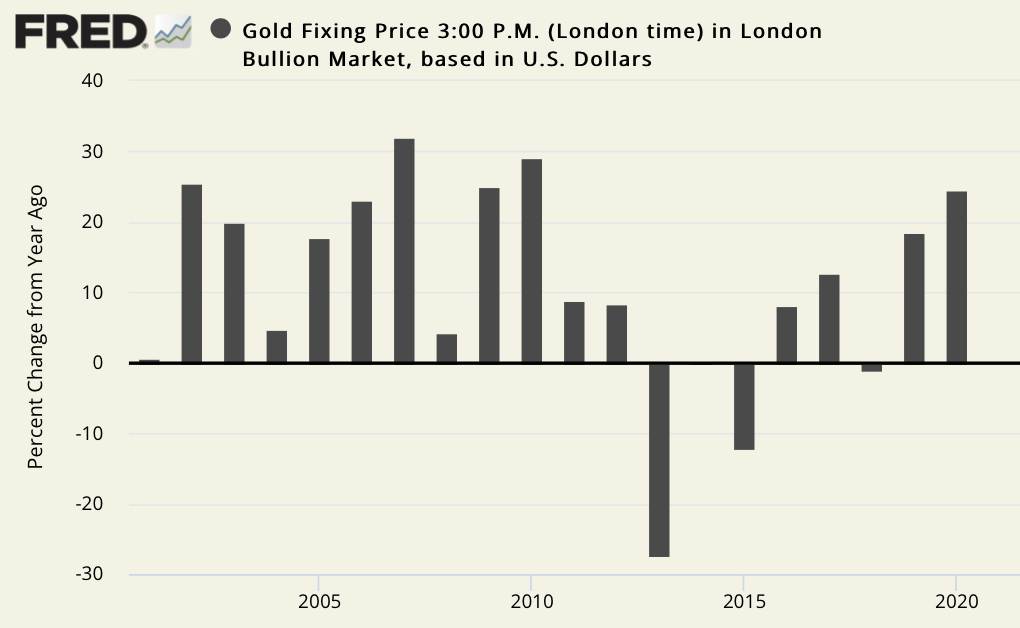
Sources: St. Louis Federal Reserve, ICE Benchmark Administration
1. Gold has produced positive returns in 16 of the last 20 years.
2. Gold’s average annual return compounded since 2001 is 10.32%. (2001-2020)
3. Gold has been a portfolio stalwart. A $100,000 investment in gold in January 2001 would be worth about $655,000 today. At gold’s peak in 2020, it would have been worth over $750,000.
4. Gold does not have a political preference. Its ascent has occurred during the terms of four presidents – two Democrats (Bill Clinton and Barack Obama) and two Republicans (George Bush and Donald Trump). Its largest gain – 31.92% in 2007 – came under a Republican (Bush). Its second-largest increase – 29.24% in 2009 – came under a Democrat (Obama).
5. Gold is not swayed by who leads the Federal Reserve. Its ascent has occurred during the terms of four different Fed chairs with four distinctly different styles and approaches to monetary policy – Alan Greenspan, Ben Bernanke, Janet Yellen, and Jerome Powell – and under a variety of economic circumstances and events.
6. Contrary to popular belief, gold does not need inflation to appreciate in value. In 2001, the average inflation rate was 2.8%. In 2018, it was 2.4%. Between those bookend years, the inflation rate exceeded 3% only three times. Its lowest reading was 0.1% in 2015. In short, some of gold’s best years were the result not of inflation but disinflation.
7. Gold’s price history is only loosely connected to that of the dollar. In January 2001, the U.S. Dollar Index stood at 113.39. It now stands at just under 93.25 for a decline of just under 18% during the period. On the other hand, the price of gold rose 6.55 times – a pace well ahead of the dollar’s performance against other national currencies.
8. The 21st century has been gold’s century, not the stock market’s. In January 2001, the Dow Jones Industrial Average stood near 9,850. With its recent sharp advances taken into account, it is now just under the 34,000 mark for a gain of roughly 353%. By contrast, gold is up over 650% during the same period (from $270 to $1760 per ounce) even with its correction over most of 2021 taken into account. Thus, while stocks dominated headlines, gold quietly performed.
The question becomes whether or not an investment that has performed so well in the past is likely to perform equally well in the future. Though nothing in the world of finance and economics is inevitable, the bullish case for gold rests on the understanding that none of the economic and financial system problems that drove gold higher over the last nearly twenty-one years have been removed from consideration. In fact, in view of the pandemic’s onslaught and the response from the federal government and central bank, a case could be made that they have only intensified and, some would say, dangerously so.
‘The next decade will belong to gold.’
“Few people acknowledge that gold remains the superior asset of the 21st century,” writes London-based analyst Charlie Morris in a recently published Atlas Trust Gold Report, “nearly twice as profitable as the S&P 500. But it was a game of two halves with gold obliterating equities in the first and the S&P smashing gold in the second. Still, gold wins overall. I can’t help but think the next decade will belong to gold. After all, the S&P 500 trades at a lofty valuation by historical standards, while gold doesn’t. The main reason I have confidence that gold will win the 2020s is that this almighty asset bubble all around us will implode, and the crowded trades will disappoint the most. Gold is far from being crowded.”
In support of Morris’ contention that “the next decade will belong to gold,” we offer four instructive charts from Merk Investments. The first two show the close correlation between real rates of return and the price of gold. In the past, the declining real rate of return was driven by the rate side of the equation. Now, rising inflation expectations have become the primary influence – a development likely to focus increased attention on the yellow metal. The third chart shows the relationship between long-term growth in the global money supply and rising gold prices. Central bank stimulus is now feeding into the global money supply (something it did not do during the Great Financial Crisis (2008), and, as a result, we might see an acceleration in both trend lines – money supply and gold. The fourth and final chart is by far the most intriguing. It matches up the cyclical lows posted in 1999 and 2015 and shows gold now closely tracking the trajectory of its twenty-year secular bull market begun in the early 2000s.
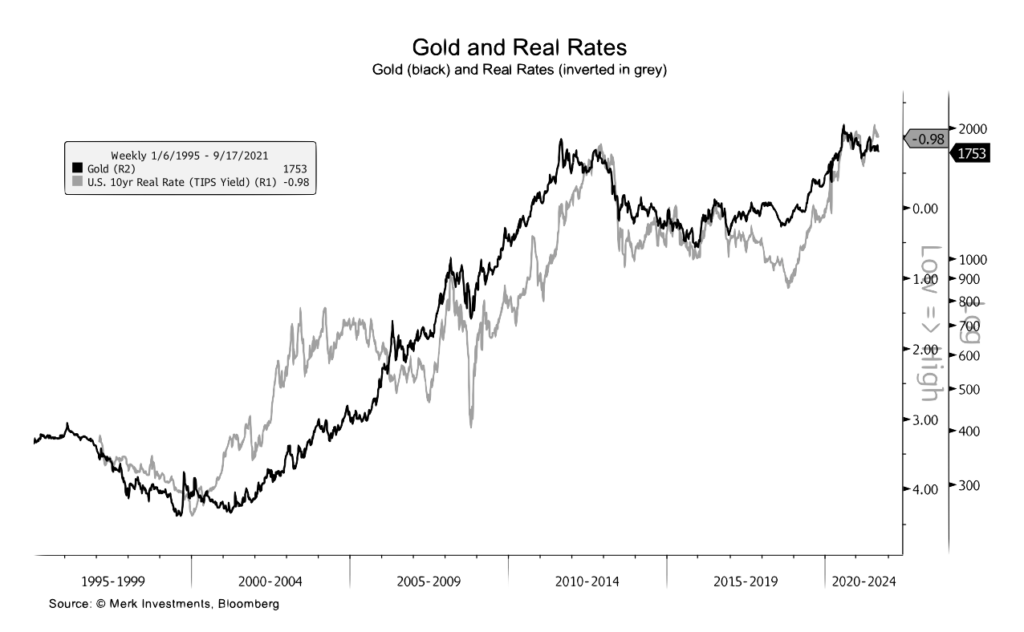
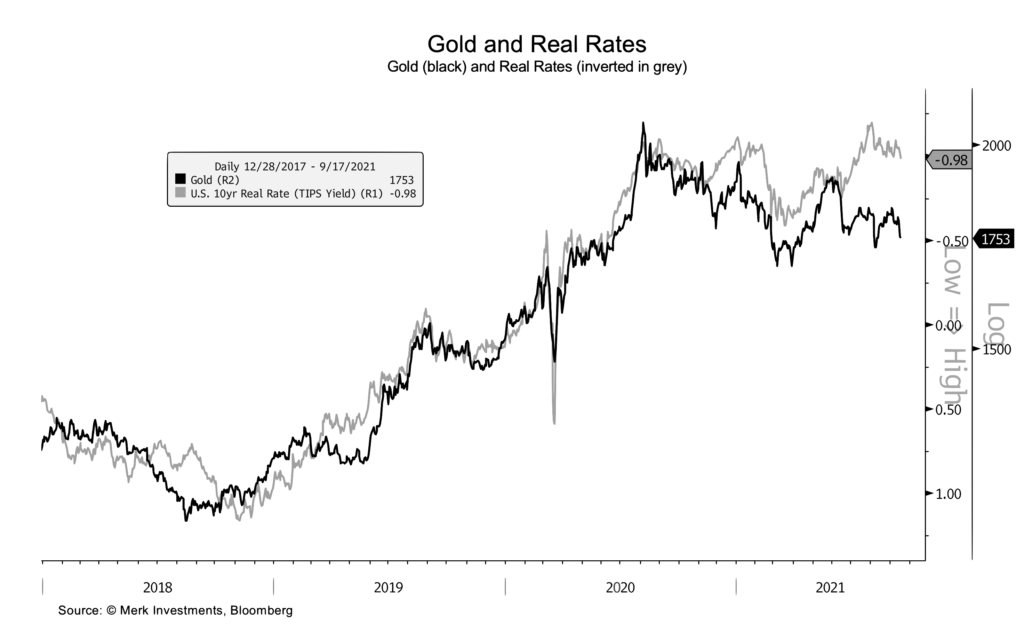
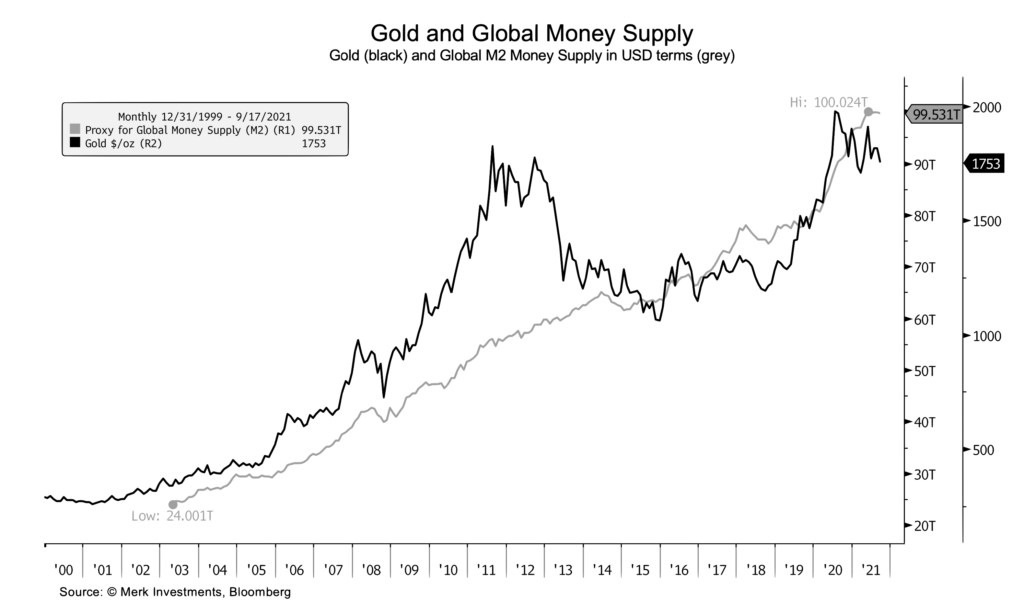
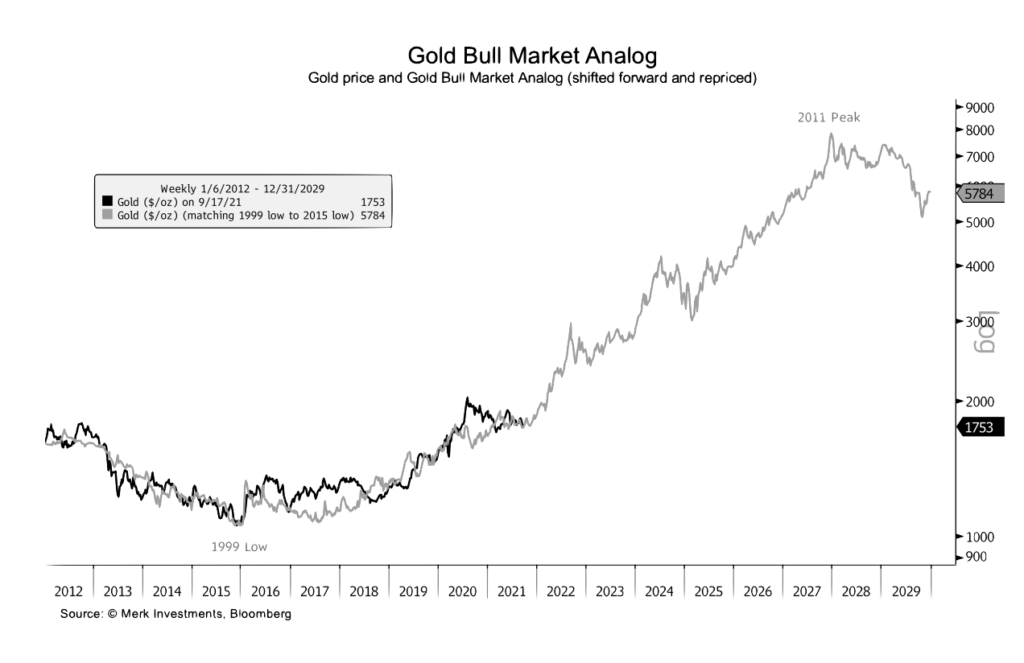
Charts courtesy of Merk Investments • • • Click to enlarge
Structuring your portfolio for the rest of the 2020s
“Precious metals are and always have been the ultimate insurance,” says Pro Aurum’s Robert Hartman in an interview with Claudio Grass. “They provide protection both against state failures and against mistakes in the monetary policy of the central banks. Every investor who looks into the history books sees that both have happened over and over again in the past centuries. From that perspective, investing in physical gold and silver is a common-sense precaution and a necessary part of any wealth preservation plan. Investors and ordinary savers ignore this at their peril and the failure to include precious metals in one’s portfolio is pure negligence.”
There are essentially two broad schools of thought alive and well in the gold market. The first holds that crisis is around the corner and, as a result, precious metals should be owned to profit from the event. The second holds that crisis is a permanent fixture in the market dynamic and that the portfolio should always include precious metals as the ultimate safe haven. The first buyer sees precious metals as investment products, i.e., buy now and sell later when the time is right. The second sees gold and silver, like Hartmann, as insurance products to be held for the long run. Some combine the two, allocating one part of their precious metals portfolio for trading purposes and another as a permanent, or semi-permanent, store of value. The novice precious metals owner must decide where he or she stands in this regard because it determines, in turn, which products to include in the portfolio and to what degree.
Investors often ask about the percentage commitment one should make to precious metals in a well-balanced investment portfolio. Analyst Michael Fitzsimmons offered an interesting take on that subject in a recent Seeking Alpha editorial, “Assuming a well-diversified portfolio (which does include cash for emergencies),” he says, “my belief is that middle-class investors (net worth under $1 million), should own at least 5-10% in gold. I also believe that as an American investor’s net worth climbs, the higher that percentage should be because, in my opinion, he or she simply has more to lose by a falling US$. For instance, an investor with a net worth of $2-5 million might have a 15-20% exposure to gold; $10 million, perhaps a 30-40% exposure.” As it has for many years, USAGOLD recommends a diversification of between 10% and 30% depending on your view of the risks at large in the economy and financial markets.
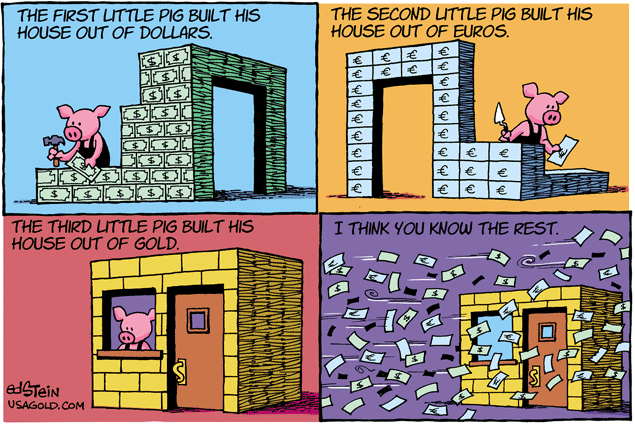
––––––––––––––––––––––––––––––––––––––––––––––––––––––––––––––––––––––––––––––––––––––––––––––––––
Looking to prepare your portfolio for whatever uncertainty lies ahead
DISCOVER THE USAGOLD DIFFERENCE
ORDER DESK: 1-800-869-5115 x100/orderdesk@usagold.com
ORDER GOLD & SILVER ONLINE 24-7

–––––––––––––––––––––––––––––––––––––––––––––––––––––––––––––––––––––––––––––––––––––––––––––
Disclaimer – Opinions expressed on the USAGOLD.com website do not constitute an offer to buy or sell or the solicitation of an offer to buy or sell any precious metals product, nor should they be viewed in any way as investment advice or advice to buy, sell or hold. USAGOLD, Inc. recommends the purchase of physical precious metals for asset preservation purposes, not speculation. Utilization of these opinions for speculative purposes is neither suggested nor advised. Commentary is strictly for educational purposes, and as such, USAGOLD does not warrant or guarantee the accuracy, timeliness, or completeness of the information found here. The views and opinions expressed at USAGOLD are those of the authors and do not necessarily reflect the official policy or position of USAGOLD. Any content provided by our bloggers or authors is solely their opinion and is not intended to malign any religion, ethnic group, club, organization, company, individual, or anyone or anything.
–––––––––––––––––––––––––––––––––––––––––––––––––––––––––––––––––––––––––––––––––––––––––––––
 Michael J. Kosares is the founder of USAGOLD, author of The ABCs of Gold Investing – How To Protect and Build Your Wealth With Gold [Three Editions], and the firm’s publications editor.
Michael J. Kosares is the founder of USAGOLD, author of The ABCs of Gold Investing – How To Protect and Build Your Wealth With Gold [Three Editions], and the firm’s publications editor.


